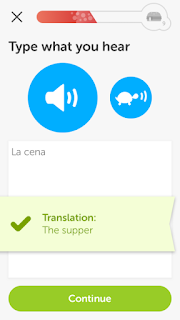Learning a language made fun and free!
This application combines the tough task
of learning a language with a game. It becomes addictive because not only do
you level up at certain times; you also earn points that unlock bonus rounds.
The neat thing about this program is that it is not only a website, but also exists in application
form for iOS
and Android,
making it easy to learn on the go!
How it all began
In 2009 the creator of reCAPTCHA, Luis von Ahn, came up with the idea to launch a game that
combined teaching its users a foreign language and classic gamification. In
2012, with the help of co-founder Severin Hacker, the language-learning
platform was launched.
Much like his first creation, the native Guatemalan wanted to ensure
that there was also a purpose behind the game; Duolingo helps translate simple
phrases in documents.
“By using technology and a little bit of fun, you can harness tiny bits of time and energy from people all around the world and make them collectively useful” (Business Insider, 2014).
Clever business plan
Coming from a poor country where people
wanted to learn English, but couldn’t seem to afford is, von Ahn vowed to keep
Duolingo free for its users. This means that he had to come up with another
tactic to keep the program, not only up and running, but also to produce
revenue. To do so Duolingo offers the option to practice language skills by
“immersion”, which boils down to users translating actual documents on the Web.
This application of crowdfunding
principles turns our mindless Internet activities into something
productive. The documents come from companies such as CNN and Buzzfeed that pay
Duolingo to translate them.
How it works:
- Documents are added to Duolingo for translation
- A user applies for an 'upload account'
- Multiple users work on translating the same document
- Users can then up/down vote translations
- A final translation is sent to the company
“For the users, it's another language-learning tool; for Duolingo, it's a way of generating hundreds of thousands of dollars” (Business Insider, 2014).
Since 2015, Duolingo has shifted gears in
their business model and will focus future endeavors on language certification as a
revenue source because they didn’t want to turn into a translation business. The
platform also boasts over $83.3 million from venture capitalists, private
investors and other investment firms that hold a stake in Duolingo (Techcrunch,
2015).
Products
Language Courses
There are 20 languages offered to native
English speakers and 9 in development. For non-native English speakers there
are a handful of other language courses offered.
Languages are taught through written and
oral exercises. When a lesson is completed users earn points, and validate the lesson when they reach 10 points. It is also possible to loose a life if the
lesson cannot be completed successfully. Skills
are considered “learned” when the user completes all the lessons associated
with that skill.
There is also the possibility to unlock bonus skills
with lingots (see section about
currency). Some of the bonus skills include themes such as ‘Flirting’, ‘Idioms’
and ‘Proverbs’.
All data is saved to the program so that Duolingo keeps
a record of where users struggle and what sorts of mistakes they make in order
to cater more precisely to specific needs and make sure languages stay fresh in
the users memory.
Currency
The currency of Duolingo is called a lingot. These are earned by finishing a skill,
leveling up, playing for a week straight or by uploading documents to the
Immersion section. With your lingots you can buy power-ups, practice or bonus
skills, and in the mobile version of the application you van even customize the
appearance of the Duolingo mascot, which is by default a green owl.
Test Center
To be recognized as speaking a language
one needs to be certified. Most often this certification happens by taking a
standardized test. Those tests tend to cost a lot of money.
So what did Duolingo do? On July 22, 2014 Duolingo
Test Center was launched. Making it possible to take the test in the comfort of your own home for
the price of $20. The test can be accessed through the website or the mobile
application and will be graded within 48 hours.
According to a study conducted by University of Pittsburgh, there is a substantial correlation between the scores on Duolingo Test Center and TOEFL iBT.
According to a study conducted by University of Pittsburgh, there is a substantial correlation between the scores on Duolingo Test Center and TOEFL iBT.
“34 hours on Duolingo teaches the equivalent of one semester of a college language course” (von Ahn).
This makes
it clear why this new media form is and will stay free. There are endless
alternatives to monetizing this platform. This democratisation of language-learning
should be for individual worldwide.




No comments:
Post a Comment